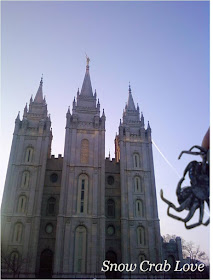Dr. Jodi Pirtle is heading away from Alaska for a bit, so for her going-away party Miranda Westphal made these amazing marine invertebrate cupcakes:
Miranda's intertidal scene: a hermit crab, sea stars, an anemone,
a sea cucumber, scallop, chiton, and barnacles!!
(sorry for the lighting; I was using a headlamp!)
adorable marzipan hermit crab with chocolate pebbles
the artist herself with the cupcake I chose
(I love sea cucumbers almost as much as I love crabs)
I was so impressed by her craftiness that I started looking up other delightful crabby cupcakes. These were some of my favorites:
beach party!
this one's for those blue crab/blue king crab lovers
I also found cute Dungie-like cupcakes that came with a recipe! It’s from the book “A Zombie Ate My Cupcake!” by Lily Vanilli (so many good things in that sentence).
Ingredients:
1 batch of red velvet, lemon or almond cupcakes (or any flavor of your choice)
½ batch of vanilla frosting
Large packet of marzipan (approx. 1lb 2oz/500g)
Dark pink and black food coloring
Dark red luster dust
Directions:
(Make the cupcakes first and let them cool a bit; these directions are for the cupcake-to-crab transformation.)
1. Smear a small dollop of vanilla frosting over the top of the cupcakes, saving a little frosting for the crab “eyes”.
2. Reserve a small amount of uncolored marzipan to make the “eyes”. Color the remainder of the marzipan dark pink by adding a few drops of food coloring and kneading it in, ensuring that the coloring is evenly distributed. Add more coloring, little by little, until you achieve the desired depth of color.
3. To make the crab’s “shells”, roll out the marzipan to a thickness of ¼ inch. Cut out 12 circles approximately 2½ inches in diameter, or slightly larger than the top of the cake.
4. Shape the crabs’ “claws” out of marzipan, rolling the marzipan into a claw shape and then adding detail with a toothpick or a taper cone tool.
5. Brush these shaped marzipan pieces all over with the luster dust, using a fine paintbrush.
6. Lay a shell gently over the top of each cake, leaving a gap at the front and adding two dots of vanilla frosting for the “eyeballs”. Then gently tuck the “claws” under the “shell” in the position you want them, securing with some more of the frosting.
7. Color the reserved marzipan black by kneading in a drop of black food coloring. Roll into tiny balls and secure a marzipan “pupil” in each of the frosting “eyeballs”.
ENJOY!




























